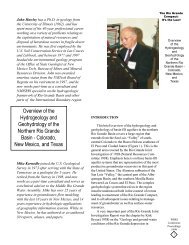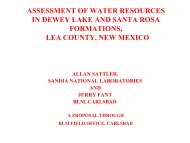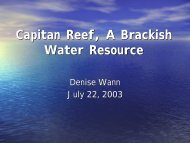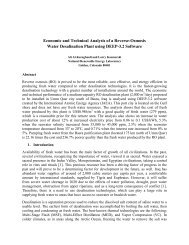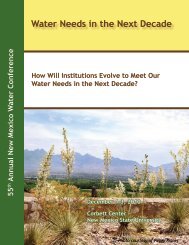Charles T. DuMars - Water Resources Research Institute
Charles T. DuMars - Water Resources Research Institute
Charles T. DuMars - Water Resources Research Institute
Create successful ePaper yourself
Turn your PDF publications into a flip-book with our unique Google optimized e-Paper software.
Prior Appropriation Law and Future <strong>Water</strong> Allocation: Preserving <strong>Water</strong> for Future Generations<br />
Em Hall is going to speak today on the origins of<br />
water law doctrine in New Mexico and how the<br />
doctrine varied historically by region within the State.<br />
And that will give us a very interesting discussion. The<br />
reason the prior appropriation doctrine has been so<br />
durable can be found in its evolution. Today’s times<br />
are not the only times when businesses have clashed<br />
with farmers, when politics have pressed private<br />
property.<br />
EVOLUTION OF THE DOCTRINE AND THE<br />
LESSONS APPLICABLE TO TODAY’S<br />
WORLD<br />
From the 1800s to the 1850s, there was really very<br />
little need for water law in the Eastern or the Western<br />
United States. In the Eastern United States there was<br />
little need for water law because there was more of it<br />
than they needed. Population centers had ample water<br />
supply. The riparian doctrine of water law in the East<br />
borrowed its principles from the common law of<br />
England. The common law simply holds that if<br />
somebody is bothering your water source, you can stop<br />
them as a nuisance if their actions are interfering with<br />
your reasonable use of this common resource.<br />
But the English common law never addressed in<br />
any sense the consequences of natural scarcity that<br />
exists in the West. Eastern streams did not dry up when<br />
a person upstream took all the water from a<br />
downstream user in an ephemeral stream leaving<br />
someone’s cattle to die.<br />
In the Western United States, there are a number<br />
of factors that led to the need for the development of<br />
this doctrine. We look at expanding populations in the<br />
new Western cities, but Western population expansion<br />
is as old as water scarcity in the West itself. It is<br />
interesting to look at the numbers on urbanization and<br />
how, from 1850 to 1900, the gold mining influences,<br />
the 49ers, that whole period of time from ‘49 to ‘72<br />
and up to the Great Depression of 1886, populations<br />
more than quadrupled. During that period of time, the<br />
West changed dramatically. The small streams with<br />
erratic flows, which had previously been quite<br />
adequate, were now found to be very inadequate<br />
because during times of scarcity there wasn’t enough<br />
to go around. There were federal proposals throughout<br />
the West at that time to encourage settlement. There<br />
were land programs that encouraged people if they<br />
could find a water source to homestead.<br />
A combination of land development policy, which<br />
encouraged settlement and the actual needs of certainty<br />
for those who had invested their capital in what turned<br />
out to be a “dry farm” in June and July, or a place mine<br />
that needed water called out for a water law that would<br />
work. The answer was prior appropriation, it was not<br />
and is not perfect but it provided a method to adapt to<br />
shortage that was acceptable.<br />
No one was going to invest in a mine or invest in<br />
agricultural development that used water or anything<br />
else in the West in the 1880s unless they had some<br />
real certainty for the<br />
people who were putting<br />
up the capital. The<br />
identical fights over the<br />
appropriateness of the<br />
doctrine appear in cases<br />
of the 1890s. No doubt,<br />
an obituary to the<br />
doctrine was written by<br />
a politician of the period<br />
The answer was<br />
prior appropriation,<br />
it was not and is not<br />
perfect but it<br />
provided a method<br />
to adapt to shortage<br />
that was acceptable.<br />
hoping to move water to his constituents as a means<br />
of staying in office.<br />
But, there was insufficient capital in many cases<br />
to take advantage of the hydrographs of the regions.<br />
The Reclamation Act of 1902 recognized that if you<br />
were going to harness Western rivers, you needed to<br />
have reservoirs. Erratic flows and huge variability<br />
required that if you were going to produce with water<br />
you needed to be able to store it and release it at a rate<br />
which would be useful during the irrigation season and<br />
you also needed to store it for flood protection.<br />
The Reclamation Act of 1902 paid for and<br />
encouraged infrastructure; the Desert Lands Act of<br />
1877 vested water rights in private individuals. Both<br />
encouraged development and rewarded people for<br />
coming out and using water resources of the West.<br />
These laws were bottomed in the notion that there<br />
was a separate set of water needs and water right<br />
needs in the West distinguishable from those in the<br />
Eastern United States.<br />
There is no doubt that some of the choices of<br />
federal subsidies for projects with negative cost/benefit<br />
ratios and the absence of the knowledge of the effects<br />
of some of these reservoirs and projects were short<br />
sighted. But seen through the lens of the engineers of<br />
the time, those choices generated wealth for those<br />
seeking to better their lot and willing to farm to make<br />
their lives better. Making the desert green may have<br />
of course been a double entendre that at times resulted<br />
13





